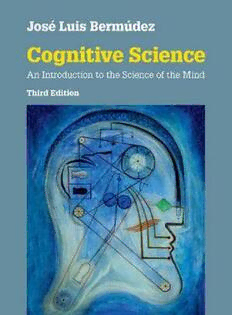
Cognitive Science: An Introduction to the Science of the Mind PDF
Preview Cognitive Science: An Introduction to the Science of the Mind
COGNITIVE SCIENCE Third edition The third edition of this popular and engaging text consolidates the interdisciplinary streams of cognitivesciencetopresentaunifiednarrativeofcognitivescienceasadisciplineinitsownright. Itteachesstudentstoapplythetechniquesandtheoriesofthecognitivescientist’s“toolkit”–the vast range of methods and tools that cognitive scientists use to study the mind. Thematically organized, Cognitive Science underscores the problems and solutions of cognitive science rather than more narrowly examining individually the subjects that contribute to it – psychology, neuroscience, linguistics, and so on. The generous use of examples, illustrations, and applications demonstrates how theory is applied to unlock the mysteries of the human mind. Drawing upon cutting-edge research, the text has been substantially revised, with new material on Bayesian approaches to the mind and on deep learning. An extensive online set of resources is available to aid instructors and students alike. Sample syllabi show how the text can support a variety of courses, making it a highly flexible teaching and learning resource at both the undergraduate and graduate levels. C O G N I T I V E S C I E N C E An Introduction to the Science of the Mind Third edition José Luis Bermúdez Texas A&M University UniversityPrintingHouse,CambridgeCB28BS,UnitedKingdom OneLibertyPlaza,20thFloor,NewYork,NY10006,USA 477WilliamstownRoad,PortMelbourne,VIC3207,Australia 314–321,3rdFloor,Plot3,SplendorForum,JasolaDistrictCentre,NewDelhi –110025, India 79AnsonRoad,#06–04/06,Singapore079906 CambridgeUniversityPressispartoftheUniversityofCambridge. ItfurtherstheUniversity’smissionbydisseminatingknowledgeinthepursuitof education,learning,andresearchatthehighestinternationallevelsofexcellence. www.cambridge.org Informationonthistitle:www.cambridge.org/9781108424493 DOI:10.1017/9781108339216 ©CambridgeUniversityPress2020 Thispublicationisincopyright.Subjecttostatutoryexception andtotheprovisionsofrelevantcollectivelicensingagreements, noreproductionofanypartmaytakeplacewithoutthewritten permissionofCambridgeUniversityPress. Firstpublished2020 PrintedinSingaporebyMarkonoPrintMediaPteLtd AcataloguerecordforthispublicationisavailablefromtheBritishLibrary. ISBN978-1-108-42449-3 Hardback ISBN978-1-108-44034-9 Paperback Additionalresourcesforthispublicationatwww.cambridge.org/bermudez3e CambridgeUniversityPresshasnoresponsibilityforthepersistenceoraccuracy ofURLsforexternalorthird-party internetwebsitesreferred tointhispublication anddoesnotguaranteethatanycontentonsuchwebsitesis,orwillremain, accurateorappropriate. CONTENTS List of Boxes xiv List of Figures xv List of Tables xxii Preface xxiii Acknowledgments for the First Edition xxxi Acknowledgments for the Second Edition xxxii Acknowledgments for the Third Edition xxxiii Introduction: The Challenge of Cognitive Science 3 PART I HISTORICAL LANDMARKS 12 1 The Prehistory of Cognitive Science 15 2 The Discipline Matures: Three Milestones 37 3 The Turn to the Brain 65 PART II MODELS AND TOOLS 96 4 Physical Symbol Systems and the Language of Thought 99 5 Neural Networks and Distributed Information Processing 123 6 Applying Dynamical Systems Theory to Model the Mind 149 7 Bayesianism in Cognitive Science 171 8 Modules and Architectures 203 9 Strategies for Brain Mapping 229 PART III APPLICATIONS 256 10 Models of Language Learning 259 11 Object Perception and Folk Physics 285 12 Machine Learning: From Expert Systems to Deep Learning 307 13 Exploring Mindreading 335 14 Mindreading: Advanced Topics 357 15 The Cognitive Science of Consciousness 379 16 Robotics: From GOFAI to Situated Cognition and Behavior-Based Robotics 407 17 Looking Ahead: Challenges and Opportunities 437 Glossary 444 Bibliography 454 Index forCognitive Science (3rd edition) 478 v CONTENTS List of Boxes xiv List of Figures xv List of Tables xxii Preface xxiii Acknowledgments for the First Edition xxxi Acknowledgments for the Second Edition xxxii Acknowledgments for the Third Edition xxxiii Introduction: The Challenge of Cognitive Science 3 0.1 Cognitive Science: An Interdisciplinary Endeavor 3 0.2 Levels of Explanation: The Contrast between Psychology and Neuroscience 5 How Psychology Is Organized 6 How Neuroscience Is Organized 7 0.3 The Challenge of Cognitive Science 10 Three Dimensions of Variation 10 The Space of Cognitive Science 10 PART I HISTORICAL LANDMARKS 12 1 The Prehistory of Cognitive Science 15 1.1 The Reaction against Behaviorism in Psychology 16 Learning without Reinforcement: Tolman and Honzik,“‘Insight’ in Rats” (1930) 17 Cognitive Maps in Rats? Tolman, Ritchie, and Kalish,“Studies in Spatial Learning” (1946) 20 Plans and Complex Behaviors: Lashley,“The Problem of Serial Order in Behavior” (1951) 21 1.2 The Theory of Computation and the Idea of an Algorithm 22 AlgorithmsandTuringMachines:Turing,“OnComputableNumbers,withanApplication to the Decision Problem” (1936–7) 23 1.3 Linguistics and the Formal Analysis of Language 25 The Structure of Language: Chomsky’s Syntactic Structures(1957) 26 vii viii Contents 1.4 Information-Processing Models in Psychology 28 How Much Information Can We Handle? George Miller’s “The Magical Number Seven, Plus or Minus Two” (1956) 29 The Flow of Information: Donald Broadbent’s“The Role of Auditory Localization in Attention and Memory Span” (1954) and Perception and Communication (1958) 30 1.5 Connections and Points of Contact 32 2 The Discipline Matures: Three Milestones 37 2.1 Language and Micro-worlds 38 Natural Language Processing: Winograd, Understanding Natural Language(1972) 39 SHRDLU in Action 41 2.2 How Do Mental Images Represent? 47 Mental Rotation: Shepard and Metzler,“Mental Rotation of Three-Dimensional Objects” (1971) 48 Information Processing in Mental Imagery 50 2.3 An Interdisciplinary Model of Vision 53 Levels of Explanation: Marr’s Vision (1982) 53 Applying Top-Down Analysis to the Visual System 55 3 The Turn to the Brain 65 3.1 Cognitive Systems as Functional Systems? 66 3.2 The Anatomy of the Brain and the Primary Visual Pathway 68 The Two Visual Systems Hypothesis: Ungerleider and Mishkin, “Two Cortical Visual Systems” (1982) 70 3.3 Extending Computational Modeling to the Brain 76 A New Set of Algorithms: Rumelhart, McClelland, and the PDP ResearchGroup, Parallel Distributed Processing: Explorations in the Microstructure of Cognition (1986) 77 Pattern Recognition in Neural Networks: Gorman and Sejnowski,“Analysis of Hidden Units in a Layered Network Trained to Identify Sonar Targets” (1998) 78 3.4 Mapping the Stages of Lexical Processing 80 FunctionalNeuroimagingwithPET:Petersen,Fox,Posner,andMintun,“PositronEmission TomographicStudiesoftheCorticalAnatomyofSingle-WordProcessing” (1988) 81 Petersen, Fox, Posner, and Mintun,“Positron Emission Tomographic Studies of the Cortical Anatomy of Single-Word Processing” (1988) 81 3.5 Studying Memory for Visual Events 84 Functional Neuroimaging with fMRI 86 Brewer, Zhao, Desmond, Glover, and Gabrieli, “Making Memories: Brain Activity That Predicts How Well Visual Experience Will Be Remembered” (1998) 87
